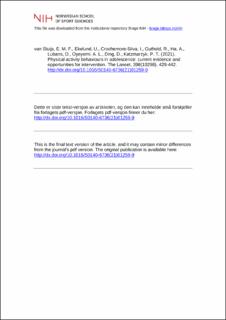Physical activity behaviours in adolescence: current evidence and opportunities for intervention
| dc.contributor.author | van Sluijs, Esther M.F. | |
| dc.contributor.author | Ekelund, Ulf | |
| dc.contributor.author | Crochemore-Silva, Inacio | |
| dc.contributor.author | Guthold, Regina | |
| dc.contributor.author | Ha, Amy | |
| dc.contributor.author | Lubans, David | |
| dc.contributor.author | Oyeyemi, Adewale L. | |
| dc.contributor.author | Ding, Ding | |
| dc.contributor.author | Katzmarzyk, Peter T. | |
| dc.date.accessioned | 2022-03-04T08:59:42Z | |
| dc.date.available | 2022-03-04T08:59:42Z | |
| dc.date.created | 2021-08-06T09:00:19Z | |
| dc.date.issued | 2021 | |
| dc.identifier.citation | The Lancet. 2021, 398(10298), 429-442. | en_US |
| dc.identifier.issn | 0140-6736 | |
| dc.identifier.uri | https://hdl.handle.net/11250/2983005 | |
| dc.description | I Brage finner du siste tekst-versjon av artikkelen, og den kan inneholde ubetydelige forskjeller fra forlagets pdf-versjon. Forlagets pdf-versjon finner du på www.sciencedirect.com / In Brage you'll find the final text version of the article, and it may contain insignificant differences from the journal's pdf version. The original publication is available at www.sciencedirect.com | en_US |
| dc.description.abstract | Young people aged 10–24 years constitute 24% of the world's population; investing in their health could yield a triple benefit—eg, today, into adulthood, and for the next generation. However, in physical activity research, this life stage is poorly understood, with the evidence dominated by research in younger adolescents (aged 10–14 years), school settings, and high-income countries. Globally, 80% of adolescents are insufficiently active, and many adolescents engage in 2 h or more daily recreational screen time. In this Series paper, we present the most up-to-date global evidence on adolescent physical activity and discuss directions for identifying potential solutions to enhance physical activity in the adolescent population. Adolescent physical inactivity probably contributes to key global health problems, including cardiometabolic and mental health disorders, but the evidence is methodologically weak. Evidence-based solutions focus on three key components of the adolescent physical activity system: supportive schools, the social and digital environment, and multipurpose urban environments. Despite an increasing volume of research focused on adolescents, there are still important knowledge gaps, and efforts to improve adolescent physical activity surveillance, research, intervention implementation, and policy development are urgently needed. | en_US |
| dc.language.iso | eng | en_US |
| dc.subject | adolescent | en_US |
| dc.subject | adolescent health | en_US |
| dc.subject | adult | en_US |
| dc.subject | child | en_US |
| dc.subject | exercise | en_US |
| dc.subject | female | en_US |
| dc.subject | global health | en_US |
| dc.subject | humans | en_US |
| dc.subject | male | en_US |
| dc.subject | schools organization and administration | en_US |
| dc.subject | screen time | en_US |
| dc.subject | sedentary behavior | en_US |
| dc.subject | young adult | en_US |
| dc.title | Physical activity behaviours in adolescence: current evidence and opportunities for intervention | en_US |
| dc.type | Peer reviewed | en_US |
| dc.type | Journal article | en_US |
| dc.description.version | acceptedVersion | en_US |
| dc.source.pagenumber | 429-442 | en_US |
| dc.source.volume | 398 | en_US |
| dc.source.journal | The Lancet | en_US |
| dc.source.issue | 10298 | en_US |
| dc.identifier.doi | 10.1016/S0140-6736(21)01259-9 | |
| dc.identifier.cristin | 1924297 | |
| dc.description.localcode | Institutt for idrettsmedisinske fag / Department of Sports Medicine | en_US |
| cristin.ispublished | true | |
| cristin.fulltext | postprint | |
| cristin.qualitycode | 2 |
Tilhørende fil(er)
Denne innførselen finnes i følgende samling(er)
-
Artikler / Articles [2096]
-
Publikasjoner fra Cristin [1084]
